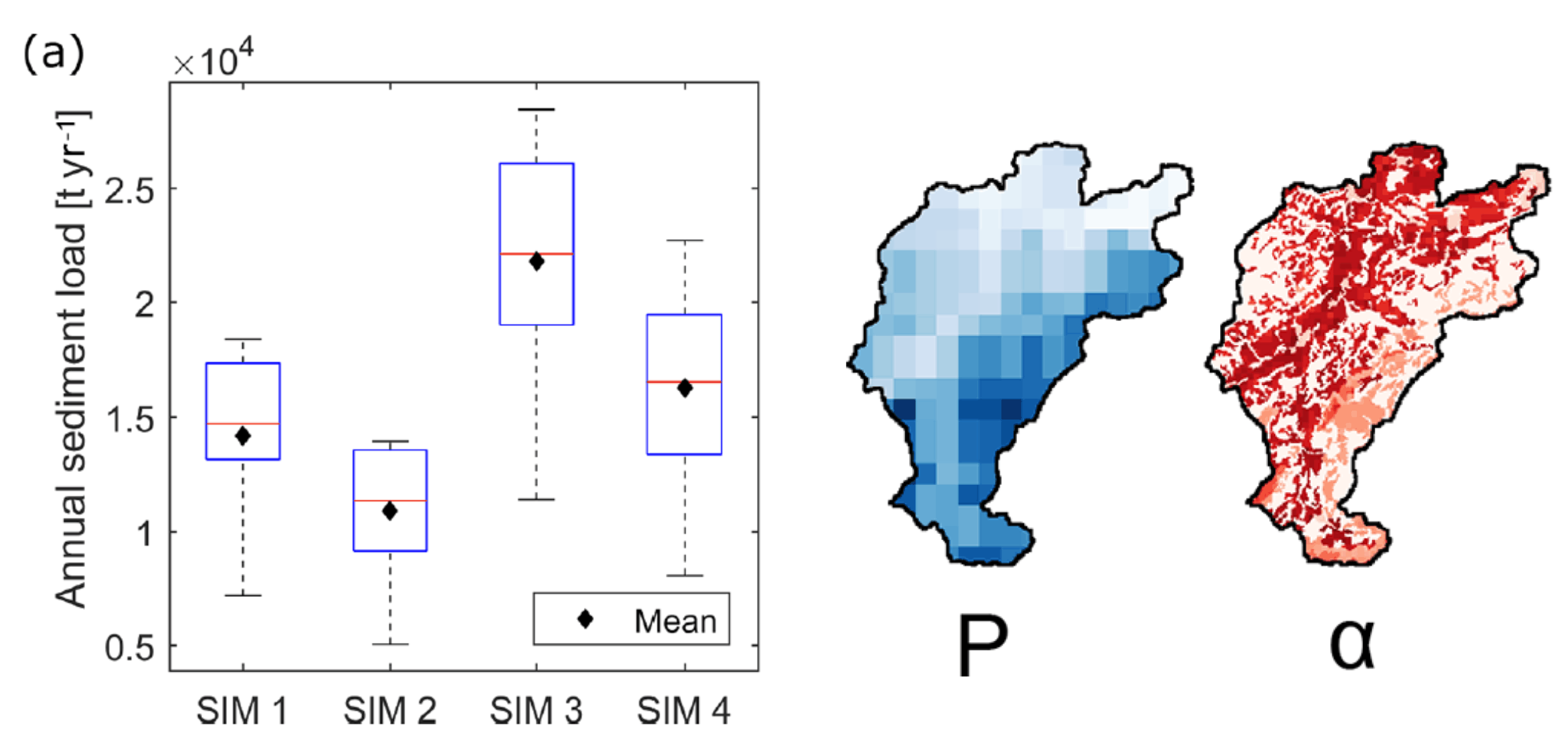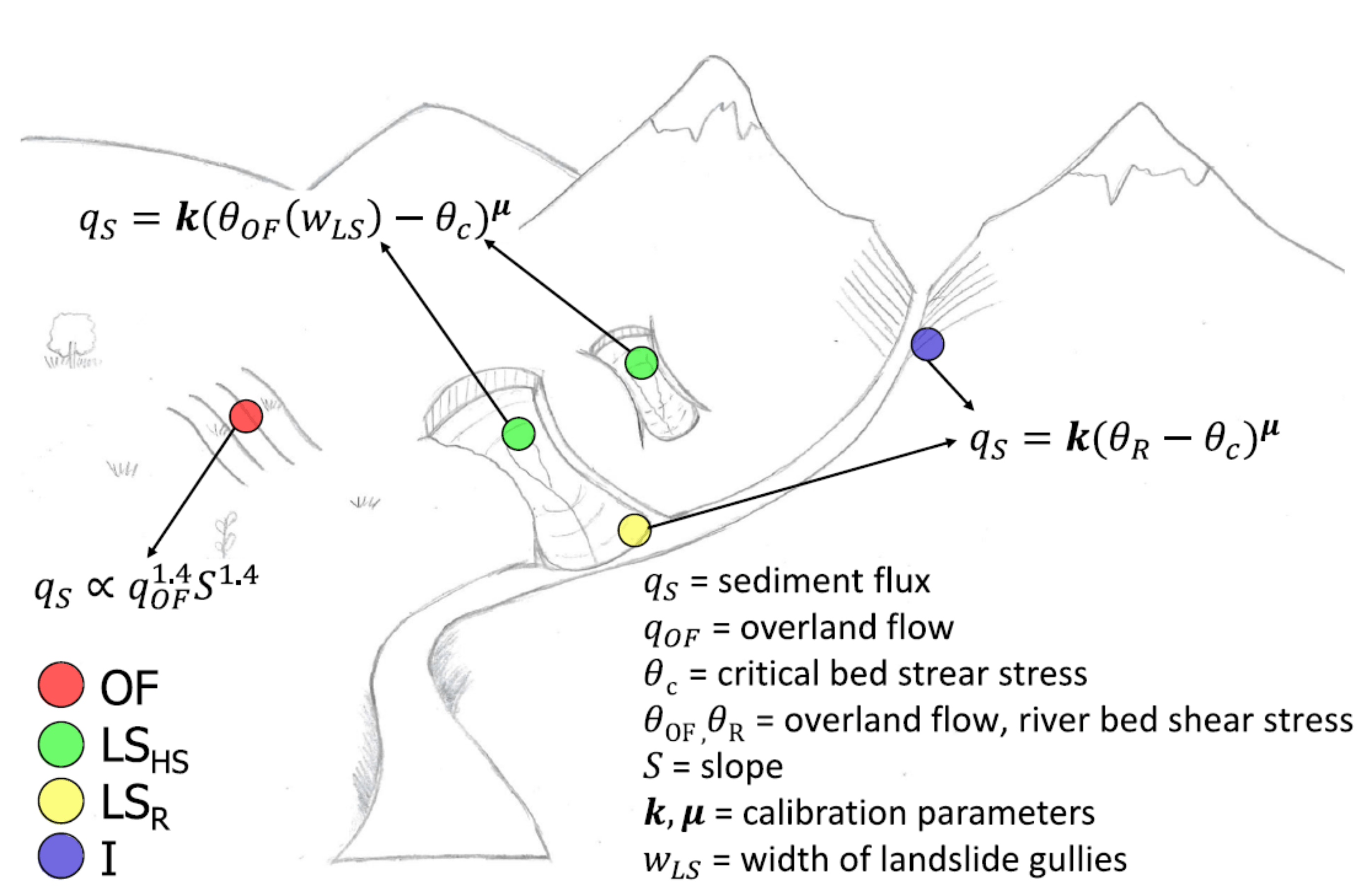S2S - Modelling Source-2-Sink Sediment Pathways
a follow-up project beings in April 2023...
Dates: 2017-2021
Funding: EU Dafne Project
PhD Student: Giulia Battista
Dissertation: research-collection (2021)
Principal Investigator: Paolo Burlando, Peter Molnar
The transfer of sediment from sources to sinks (S2S) at catchment scales is driven by overland and channel flow. To make this hydrology-sediment connection in numerical models we need physically-based fully-distributed approaches at suitable temporal (hourly) and spatial (10-100 m) resolutions. Such models allow the grain size dependent tracking of sediment from sources to sinks. In the S2S project we have developed a fine sediment module in the hydrological model TOPKAPI-ETH with which we investigated the main elements of the sediment tracking problem at catchment scales. We focussed in particular on (a) the impact of climate (rainfall) and surface (erodibility) spatial variability on sediment yields; (b) the role of local sources in producing high suspended sediment concentrations, and (c) the effect of limited sediment supply. The study basin is the Kl Emme, a pre-Alpine catchment in Switzerland.
Impacts of erosion drivers: rainfall and erodibility

A new spatially distributed soil erosion and suspended sediment transport module integrated into the physically-based hydrological model TOPKAPI-ETH is used to investigate the effects of the two main erosion drivers – rainfall and surface erodibility – on catchment sediment fluxes. By conducting a series of numerical experiments in which we turn the spatial variability in erosion drivers on and off, we quantify the impacts on erosion–deposition, sediment delivery ratio, and catchment sediment yields. The main finding is that the spatial variability in erosion drivers affects sediment yield by (a) increasing sediment production due to a spatially variable precipitation, while decreasing it due to a spatially variable surface erodibility, (b) favouring the clustering of sediment source areas in space by surface runoff generation, and (c) decreasing their connectivity to the river network by magnifying sediment buffers.
Battista, G., Molnar, P., and Burlando, P. (2020) external page Modelling impacts of spatially variable erosion drivers on suspended sediment dynamics, Earth Surf. Dynam., 8, 619–635, https://doi.org/10.5194/esurf-8-619-2020
Tracking local sediment sources

The hydrology–sediment modelling framework based on the model Topkapi‐ETH was combined in this work with basin geomorphic mapping to investigate the role of localized sediment sources. The periodic sediment mobilization from incised areas and landslides by hillslope runoff and river discharge is simulated in addition to overland flow erosion. We show that accounting for localized sediment sources substantially improves the modelling of observed sediment concentrations (especially extremes) and loads at the outlet compared to overland flow erosion alone. We support simulations with two independent validations - by topographic analysis of surface roughness of landslide surfaces, and by sediment tracing with 10Be concentrations. This research shows the potential of spatially explicit modelling for sediment tracing and provenance studies.
Battista, G., Schlunegger, F., Burlando, P., and Molnar, P. (2020) external page Modelling localized sources of sediment in mountain catchments for provenance studies, Earth Surf. Process. Landforms, 45: 3475– 3487, https://doi.org/10.1002/esp.4979
Sediment supply limitations

In mountain river basins, sediment availability on hillslopes and in channels is key to predict the sediment response to hydrological forcing. In this research we introduced a variable landslide sediment supply as a function of topography, hydrology, and hillslope activity in the hydrology-sediment model TOPKAPI-ETH. We simulated a range of transport- and supply-limited conditions to quantify the variability of suspended sediment concentrations and load, and the seasonal dynamics of sediment storage. We show that supply limitation dampens the natural variability of the hydrological and sediment transport processes, and we demonstrate that alternation of low and high sediment availability favours sediment load variability at the outlet. The proposed model provides a physically-based tool to isolate the effect of transport- and supply-limited conditions in basin sediment response.
Battista, G., Schlunegger, F., Burlando, P., & Molnar, P. (2022) external page Sediment supply effects in hydrology-sediment modeling of an Alpine basin, Water Resour. Res., 58, e2020WR029408, https://doi.org/10.1029/2020WR0294